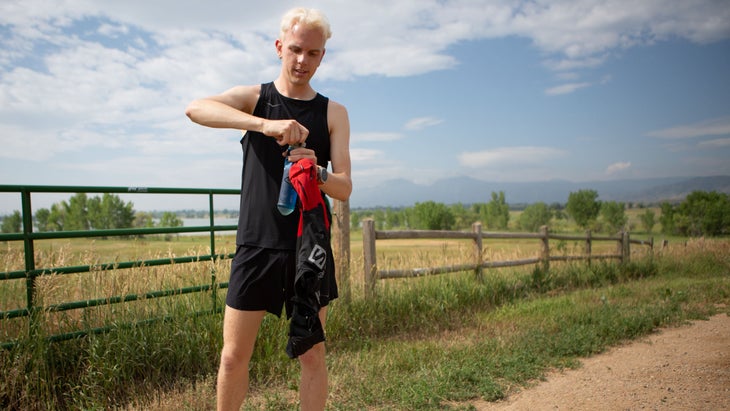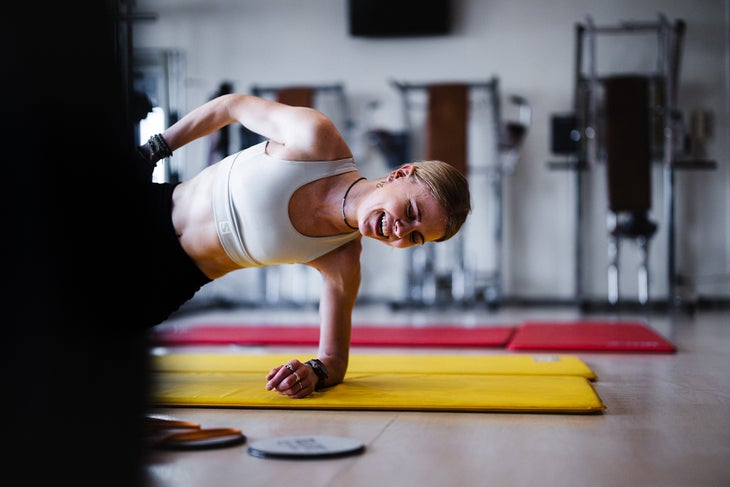When it comes to taking care of your running apparel, gear, and yourself, best practices aren’t always intuitive. Here are our top tips.
(Photo: Imgorthand/Getty)
Published September 26, 2025 12:30PM
As runners, many of us are accustomed to (even proud of) our comfort levels with feeling grimy, snot-rocketing mid-run, and recounting pre-race bathroom horror stories. Like parents of young children, we are accustomed to dealing with sweat, pee, mucus, saliva, and blood on a daily basis.
But just because we are comfortable with the many amazing functions of our bodies doesn’t mean that we have to settle for running apparel with perma-stink, moldy water bottles, and getting sick more than necessary.
Paying a little bit of attention to personal hygiene when training and racing goes a long way. And best practices aren’t always intuitive. Here are a few of our top tips for keeping your running apparel, gear, and yourself clean and healthy.
Personal Hygiene Tips for Runners

1. Don’t Re-Wear (Polyester) Workout Clothes
After huffing and puffing up the neighborhood hill and working up a sweat, you should always wash your clothes. This will help reduce odors and simultaneously limit bacteria count. However, after a light jog, it can be tempting to save some water and energy by folding your clothes back up for next time. Whether you can do so partly depends on whether you are wearing synthetic fabrics, particularly polyester.
One small study showed that when compared to cotton, polyester clothing tends to teem with more Micrococci. This type of bacteria may not be the most malicious, but it certainly contributes to foul odors. This means that after a gentle yoga class or short jog, you might be able to get away with a second wear.
That said, you should always wash undergarments (including underwear, sports bras, and socks) after each use. Hanging clothes in the sun—whether washed or unwashed—can also help combat bacteria thanks to the antimicrobial effects of UV rays.
2. Clean Your Water Bottle After Each Use
It doesn’t matter if you use Nuun or Liquid I.V., Maurten or Mortal Hydration; if you are running with a bottle full of electrolytes, you need to clean it after each use. And no, shaking a few ounces of water in there is not enough to do the trick. You need to use a bottle brush and soap to scrub every nook and cranny of that bottle, including the lid. Tablets designed to eliminate bottle bacteria, such as Bottle Bright tablets, can also help. At the end of the day, treat your water bottle like you would any other dishware.
Why are we stressing this so much? Research has found that reusable water bottles can contain 40,000 times the amount of bacteria found on a toilet seat, with that number increasing for bottles with screw tops and spout lids. The picture becomes even more grim when you consider bottles primarily used for electrolyte consumption. If your bottle has been sitting for a few days, neglected and festering with bacteria, consider putting it through a more vigorous treatment of hot water, dish soap, and baking soda.
3. Know the Runner’s Pee Protocol
If you are someone who tends to veer off trail within the first mile or two of a run, you are not alone. The urge to go is particularly relevant for females; as much as 44 percent of women have experienced urinary incontinence while running. Furthermore, rates of stress urinary incontinence, which arises from weakened pelvic floor muscles, are higher among mothers, older women, and women on their periods.
If you can’t find a public restroom, you’ll have to pop a squat on the side of the road or trail. But don’t think that means you need to perform goofy dance moves in a low squat to dry off your nether regions. Simply attach a reusable pee cloth to your running belt or hydration system, and you’ll be good to go. Kula cloths in particular are treated with silver to help fight bacteria. They can easily be cleaned with soap and water, as well as a stint in the sun.
Meanwhile, if number two is the need of the moment, make sure to have some toilet paper packed and a Ziploc bag to pack it out, or dig a hole at least 6-8 inches deep, 200 feet from water, trails, and campsites, per leave no trace principles.
4. Always Shower After Exercising
We get it: After a challenging workout or long run, sometimes all you can think about is a tall stack of pancakes and a thick protein shake. After getting food in your system, you might then be tempted to start checking off the dozen other items on your agenda for the day. However, neither of those factors are excuses for you to forgo showering.
Experts recommend that you lather on the soap shortly after your workout ends, with the caveat that you might want to first take 10-15 minutes for your heart rate to come down. Waiting an hour or more, though, gives bacteria ample time to have a party, combining with sweat to cause body odor and skin issues, including acne and clogged pores.
Women who stay in wet clothing are also at increased risk for yeast infections. Need even more motivation to turn on the faucet? Extra benefits of showering in cold water include enhanced muscle recovery and immune benefits.

5. Stay on Top of Germs at the Gym
Wiping down gym equipment is something most of us perform religiously during flu season, but forget to do during the rest of the year. This precaution is essential, though, for minimizing your risk of infection. Use a fresh paper towel and several sprays of disinfectant each time, or use a disinfecting wipe.
Toting your own equipment to the gym—such as a yoga mat and loop bands—will go even further in helping you stay healthy. Nevertheless, you should not neglect wiping down your own equipment, either; aim for cleaning items like yoga mats with water and soap after each use and disinfecting them every 1-2 weeks.
There are a few other rules of thumb to follow at the gym. First, stay away from other folks who are coughing or sneezing, even at the expense of seeming rude. If your gym is a tight space, consider coming back later. Next, always wash your hands with soap and hot water after finishing your workout. Finally, wear sandals any time you use public showers; you’ll be grateful for the lack of warts and other infections like athlete’s foot and ringworm that thrive in warm, moist conditions.














